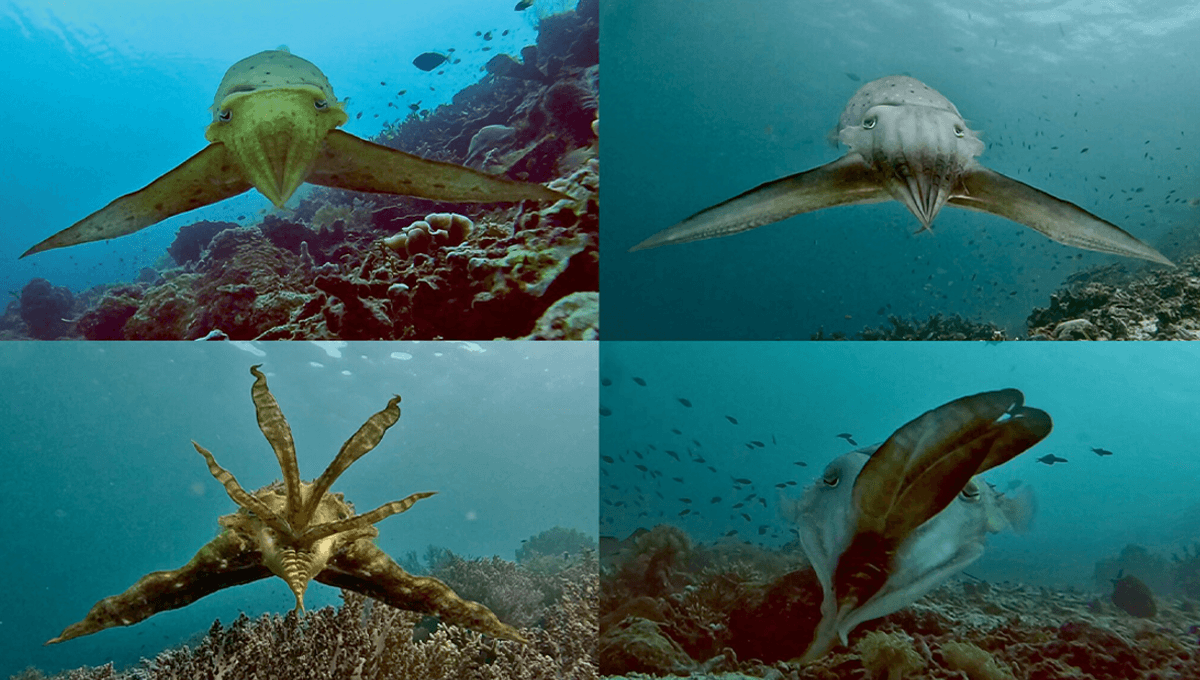
Trying to catch a meal in the animal world can generate a whole host of challenges. You must first find the prey, and then catch it without botching the attempt and losing your dinner. In the cuttlefish world, researchers have identified four impressive camouflage techniques that these mollusks use to help them pursue prey and end up with a meal.
ADVERTISEMENT
Cuttlefish have impressive control over their appearance, being able to manipulate the colors and even textures of their bodies. Broadclub cuttlefish (Sepia latimanus) typically either catch their prey with their two longer arms or use all four arm pairs to ensnare their prey. On the approach to this stage, researchers identified four distinct displays, each of which is very different to the others in terms of color, body position, and texture.
“The first time I saw these hunting displays, it was probably one of the coolest things I’ve ever seen,” study author Dr Matteo Santon told the New York Times.
Off the islands of Kri and Mansuar in eastern Indonesia, the team baited the cuttlefish with a prey of live crabs and observed them on the approach. They also filmed the behavior with a GoPro to compare between individuals. Over the 234 displays that were seen, the authors found the cuttlefish had four main hunting displays that they named leaf, passing-stripe, branching coral, and pulse display.
In the leaf attack, the lateral arms are stretched out to the side, the cuttlefish is colored olive green or white, and the approach happens extremely slowly. In the passing-stripe attack, the body position is similar to a leaf but the cuttlefish is able to pass a black stripe along its body and approaches the prey straight on.
In the branching coral attack, “The two central arm pairs are raised, and the lateral arm pair stretched dorso-laterally, occasionally held smooth or with regular kinks in the arms,” write the authors in the paper. The color of the cuttlefish remains the same in the attack but has pale or dark coloration with dark mottles.
ADVERTISEMENT
In the final display type, known as pulse, the two lateral arms come up together to form a cone, while two central arms go underwater. The body color is gray with dark pulses that pass over from behind the head to the ends of the raised arms.
The team also found that the cuttlefish mixed their displays, switching from one form to another during the approach, and suggest that some of the displays may also help hide the cuttlefish from predators.
The team found that males and females were equally likely to use all of the four displays, except for the leaf display which the females used 13 percent more frequently. They also discovered that when hunting certain prey like purple mangrove crabs, the cuttlefish used branching coral display more often than when hunting mottled crabs. This suggests the cuttlefish are tailoring their advances to specific prey.
“When using the leaf display, cuttlefish adopt a greenish color and perform slow dorso-ventral swimming oscillation during approach, reminiscent of the movement of a mangrove leaf carried by the current,” write the authors, suggesting that the cuttlefish are mimicking the motion of the leaf in an extra level to their camouflage.
ADVERTISEMENT
Overall, this study shows not only the remarkable level of camouflage capabilities within this species but also suggests a high level of cognitive ability in making decisions regarding their hunting strategies.
The paper is published in Ecology.
Source Link: Watch Cuttlefish Coming In For The Kill One Magnificent Display At A Time